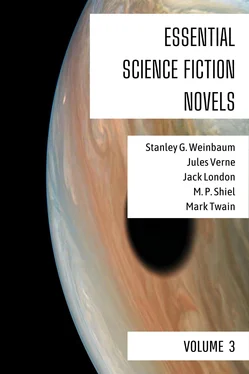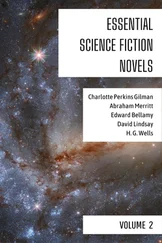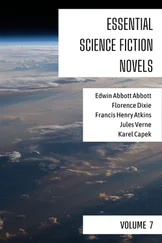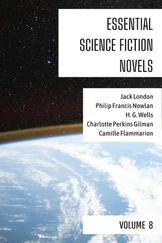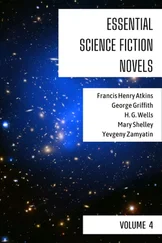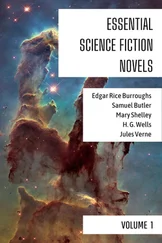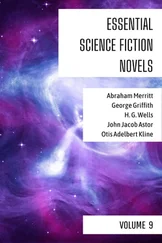Wells’s The Island of Dr. Moreau is a ghastly study in vivisection. Two scientists on a remote island with no other human inhabitants try unspeakable experiments on animals, trying by pruning and grafting and training the living tissue to make them human. They do succeed in a measure, for they teach the beasts to talk and to observe a sort of jungle law laid down by man, yet the effect is sickening. The animals are not human and never can be, and these revolting experiments deprive them of all animal dignity without adding any of the human. In the end they revert to savagery, becoming even more bestial than before. The most dreadful biological experiments in recent fiction are described in Arthur Machen’s volume of short stories, The House of Souls . In one story an operation on the brain enables a victim to “see the great god Pan,” to have revelations of ancient supernaturalism wherein Pan and the devil are united in one character. In another, a delicate cutting of the brain removes the soul,—which takes the form of a wonderful jewel,—and utterly diabolizes the character. These curious and revolting stories are advanced instances of scientific diabolism and leave a smear on the mind. They are more horrible than the creation of Frankenstein’s man-monster, for here moral monsters are evolved.
Medicated supernaturalism associated with prenatal influence occurs in various stories where a supernormal twist is given because of some event out of the ordinary. Ambrose Bierce’s The Eyes of the Panther , a story of a young woman who is a panther for part of the time as a result of a shock, is associated with the snake nature of Elsie Venner. Barry Pain’s The Undying Thing is one of the most horrible of such complications, for because of a mother’s fright over a pack of wolves a monster is born, neither wolf nor human, neither animal nor man, neither mortal nor immortal. It is hidden in a secret cave to die, yet lives on, though not living, to fulfil a curse upon the ancient house. A. Conan Doyle’s The Terror of Blue John Gap is a story of a monstrous animal, like a bear yet bigger than an elephant, that ravages the countryside. The theory for its being is that it is a survival, in a subterranean cave, of a long-extinct type, from prehistoric times, that comes out in its blindness to destroy. There are other examples of supernormal animals in modern fiction, yet these suffice to illustrate the genre .
Botany furnishes its ghostly plots in fiction as well as other branches of science, for we have plant vampires and witches and devils. Trees and flowers are highly psychic and run a gamut of emotions. Hawthorne shows us supernatural plants in several of his novels and stories, such as the mysterious plant growing from a secret grave, which has a strange poisonous power, or the flowers from Gaffer Dolliver’s garden that shine like jewels and lend a glow to the living face near them, when worn on a woman’s breast. In Rappaccini’s Daughter the garden is full of flowers of subtle poison, so insidious that their venom has entered into the life of the young girl, rendering her a living menace to those around her. She is the victim of her father’s dæmonic experiments in the effects of poison on the human body, and her kiss means death. Algernon Blackwood tells of the uncanny power of motion and emotion possessed by the trees, where the forest exercises a magnetic force upon human beings sympathetic to them, going out after men and luring them to their fate. He describes the cedar as friendly to man and attempting but in vain to protect him from the creeping malignant power of the forest.
Fu-Manchu, Sax Rohmer’s Chinese horror, performs various experiments in botany to further his dreadful ends. He develops a species of poisonous fungi till they become giant in size and acquire certain powers through being kept in the darkness. When a light is turned on them, the fungi explode, turning loose, on the men he would murder, fumes that drive them mad. From the ceiling above are released ripe spores of the giant Empusa, for the air in the second cellar, being surcharged with oxygen, makes them germinate instantly. They fall like powdered snow upon the victims and the horrible fungi grow magically, spreading over the writhing bodies of the mad-men and wrapping them in ghostly shrouds. In The Flower of Silence he describes a strange orchid that has the uncanny habit of stinging or biting when it is broken or roughly handled, sending forth a poison that first makes a man deaf then kills him. Fu-Manchu introduces this flower into the sleeping-rooms of those he wishes to put out of the way, and sends them into eternal silence. The Flowering of the Strange Orchid , by H. G. Wells, is the story of a murderous plant, a vampire that kills men in the jungle, and in a greenhouse in England sends out its tentacles that grip the botanist, drinking his blood and seeking to slay him. This orchid has the power to project its vampiric attacks when it is a shriveled bulb or in the flower. This reminds us of Algernon Blackwood’s story of the vampire soil, which after its psychic orgy burst into loathsome luxuriant bloom where before it had been barren.
It is a curious heightening of supernatural effect to give to beautiful flowers diabolical cunning and murderous motives, to endow them with human psychology and devilish designs. The magic associated with botany is usually black instead of white. One wonders if transmigration of soul does not enter subconsciously into these plots, and if a vampire orchid is not a trailing off of a human soul, the murderous blossom a revenge ghost expressing himself in that way. The plots in this type of fiction are wrought with much imagination and the scientific exactness combined with the supernatural gives a peculiar effect of reality.
There are varied forms of supernatural science that do not come under any of the heads discussed. The applications of research to weird fiction are as diverse as the phases of investigation and only a few may be mentioned to suggest the variety of themes employed. Inversion of natural laws furnishes plots,—as in Frank R. Stockton’s Tale of Negative Gravity with its discovery of a substance that enables a man to save himself all fatigue by means of a something that inverts the law of gravity. With a little package in his pocket a man can climb mountains without effort, but the discoverer miscalculates the amount of energy required to move and finally rises instead of staying on the earth, till his wife has to fish him into the second-story window. Poe’s Loss of Breath illustrates another infringement of a natural law, as do several stories where a human being loses his shadow.
In The Diamond Lens , Fitz-James O’Brien tells of a man who looking at a drop of water through a giant microscope sees in the drop a lovely woman with whom he falls madly in love, only to watch her fade away under the lens as his despairing eyes see the water evaporate. Supernatural acoustics enters in the story of a man who discovers the sound-center in an opera house and reads the unspoken thoughts of those around him. He applies the laws of acoustics to mentality and spirituality, making astounding discoveries. Bram Stoker combines superstition with modern science in his books, as where Oriental magic is used to fight the encroachments of an evil force emanating from a mummy, as also to bring the mummy to life, while a respirator is employed to keep away the subtle odor. He brings in blood transfusion together with superstitious symbols, to combat the ravages of vampires. Blood transfusion also enters into supernaturalism in Stephen French Whitney’s story, where a woman who has been buried in a glacier for two thousand years is recalled to life.
The Human Chord , by Algernon Blackwood, is a novel based on the psychic values of sounds, which claims that sounds are all powerful, are everything,—for forms, shapes, bodies are but vibratory activities of sound made visible. The research worker here believes that he who has the power to call a thing by its proper name is master of that thing, or of that person, and that to be able to call the name of Deity would be to enable one to become as God. He seeks to bring together a human chord, four persons in harmony as to voice and soul, who can pronounce the awful name and become divine with him. He can change the form or the nature of anything by calling its name, as a woman is deformed by mispronunciation, and the walls of a room expanded by his voice. He can make of himself a dwarf or a giant at will, by different methods of speaking his own name. He says that sound could re-create or destroy the universe. He has captured sounds that strain at their leashes in his secret rooms, gigantic, wonderful. But in the effort to call upon the mighty Name he mispronounces it, bringing a terrible convulsion of nature which destroys him. The beholders see an awful fire in which Letters escape back to heaven in chariots of flame.
Читать дальше
